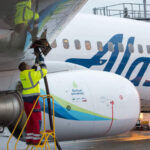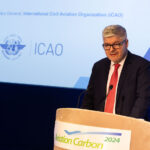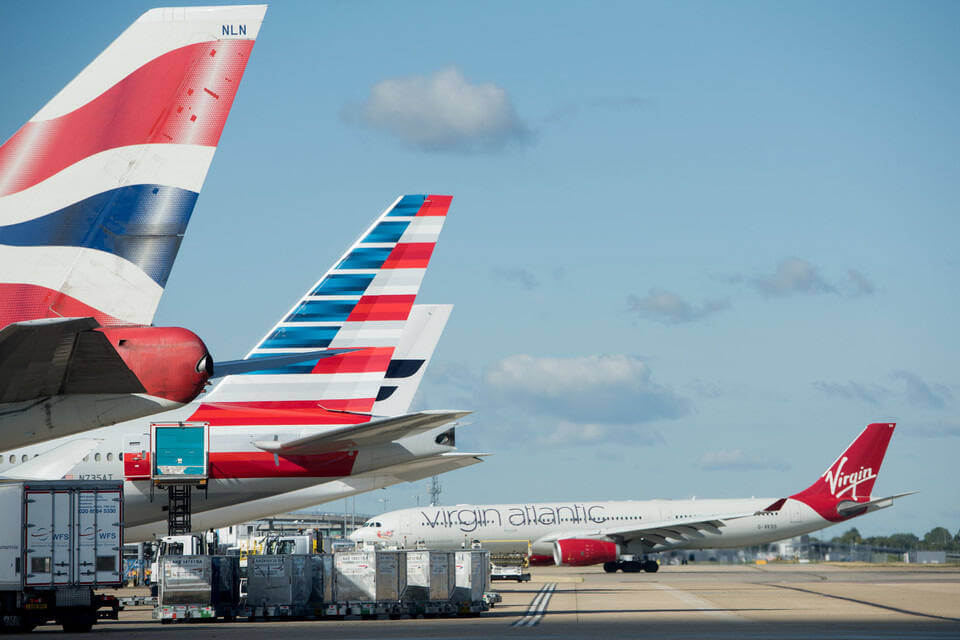As the UK prepares to adopt ICAO’s CORSIA regulations into domestic law, the Department for Transport (DfT) has opened a consultation on its proposed approach for implementing and administering the monitoring, reporting and verification (MRV) of aviation CO2 emissions from this year. The consultation also considers policy options for interaction between CORSIA and with the UK leaving the EU ETS post-Brexit, a new UK Emissions Trading Scheme that also starts in 2021. The government’s preferred option is a ‘supply-adjusted’ hybrid scheme in which aeroplane operators would be entitled to claim a reduction in their UK ETS obligations equivalent to their CORSIA CO2 offsetting obligations on flights from the UK to EEA States covered by the EU ETS. In this option, for every tonne of CO2 that is removed from the UK ETS obligations of an operator due to CORSIA, a tonne of CO2 in UK ETS allowances would also be retired from the system. This would be more environmentally stringent than a simple hybrid approach and would be fully compliant with the CORSIA regulations, believes the DfT. The six-week consultation runs until February 28.
As a contracting state of ICAO, the UK is obliged to adopt into domestic law the relevant Standards and Recommended Practices (SARPs) relating to ICAO’s CORSIA carbon offsetting scheme for international aviation. The consultation considers CORSIA implementation in terms of MRV and offsetting by operators of their CO2 emissions. A second consultation is planned for this summer on detailed proposals for implementing CORSIA offsetting in the UK.
According to the DfT, implementing CORSIA alongside the UK ETS is being guided by two principles: upholding the UK’s international obligations by implementing CORSIA “as closely as possible” to the globally-agreed SARPs and upholding the UK’s domestic climate obligations to ensure carbon pricing is at least as ambitious as the EU ETS. It says it has taken into account that options could lead to operators having to both cancel CORSIA emissions units and surrender UK ETS allowances for the same tonne of CO2 emitted and the potential for competitive distortions between operators and an increased administrative burden. While accepting aviation has significant climate impacts in addition to CO2, the government says these are not yet well enough understood to form policy with any certainty. Operators are therefore not required to monitor, report or address these non-CO2 effects but the DfT says it is possible that either or both schemes may seek to incorporate these effects in the future.
CORSIA is expected to be implemented in the UK through two statutory instruments (SI) under an Air Navigation Order. The first SI, covering CORSIA MRV, is expected to be in force by spring 2021 and the second, covering CORSIA offsetting, is aimed to come into force by the first UK ETS surrender deadline in April 2022. A further instrument called the UK ETS Order, which includes provisions relating to the aviation free allocation, has already come into force but will be amended in future to reflect the chosen policy option for interaction between CORSIA and the UK ETS.
The first SI covers:
- The attribution of aeroplane operators to a state, the role of the state in implementing CORSIA and details the MRV processes and requirements;
- The MRV of CO2 emissions produced using CORSIA eligible fuels; and
- The enforcement action if operators do not comply with their obligations under the scheme.
The government intends that operators attributed to the UK for CORSIA will be regulated by the same four regulators (for England and the devolved administrations of Scotland, Wales and Northern Ireland) as under the UK ETS – for example the Environment Agency (EA) in respect of England. Operators who are attributed to the UK for CORSIA but are not participants in the UK ETS are proposed to be regulated by the EA. A single UK CORSIA focal point will report to ICAO on behalf of all the UK regulators, with the DfT remaining the responsible authority in the UK for CORSIA, in consultation with the Department for Business, Energy and Industrial Strategy (BEIS) and the devolved administrations.
Civil penalties for non-compliance can be issued by the regulator through an enforcement notice when it believes an aspect of CORSIA implementation has been or is likely to be implemented incorrectly, and will mirror those applying to the UK ETS. Failure by an operator to apply for or make a revised application for an emissions monitoring plan, or failure to monitor or report emissions carry a penalty of £20,000 ($27,000) plus a daily rate of £500 up to a maximum of £45,000. The penalties rise to £50,000 for more serious infringements.
CORSIA-UK ETS interaction
The consultation then considers the policy options for interaction between CORSIA and the UK ETS. In its introduction, the DfT says the UK is committed to fully participating in CORSIA from the start of the scheme in 2021 but at the same time recognises further action is required to ensure international aviation contributes to the global temperature goals of the Paris Agreement.
“The UK is therefore negotiating in ICAO for a long-term goal for international emissions that, like our national targets under the Climate Change Act, is consistent with the Paris Agreement,” it says. “The UK is also acutely aware of its responsibility as COP26 President to push for great ambition in tackling climate change across all sectors. The UK will use the platform of COP26 to push for progress in decarbonising all sectors including aviation. In addition, the UK government and the devolved administrations have higher climate change ambitions than those currently set by ICAO.”
Without policy action, the DfT says CO2 emissions above the CORSIA baseline from international flights departing from the UK to the European Economic Area (EEA) would incur obligations from both the UK ETS and CORSIA, leading to operators being charged twice for these emissions. It puts forward six options in the consultation for consideration. With the exception of one, they assume UK domestic flights will only be included in the UK ETS; international flights to or from the UK that are not covered by the UK ETS would only be included in CORSIA (where the other State is also a participant in the scheme); and flights from EEA States to the UK would be covered by the EU ETS.
Option 1: Simple hybrid scheme – An operator’s UK ETS obligations would be reduced by an amount equivalent to their CORSIA obligations on flights from the UK to the EEA. In effect, this would mean that the UK ETS would apply to emissions on these flights unless they are covered by CORSIA. The option does not allow an operator to directly use CORSIA emissions units against their UK ETS obligations. The option is broadly similar to the ETS-CORSIA ‘mix’ option in an inception impact assessment published by the European Commission. This is assessed by the DfT as the simplest method and means the UK is fully compliant with the CORSIA SARPs whilst ensuring operators face obligations either under CORSIA or the UK ETS on all emissions from UK to EEA flights. However, this option would see the demand for allowances reduced without an equivalent adjustment to the supply, which could contribute to a build-up of surplus UK ETS allowances, plus add a level of complexity for operators on UK to EEA flights.
Option 2: Supply-adjusted hybrid scheme – Based on option 1, operators would be entitled to claim a reduction in their UK ETS obligations equivalent to their CORSIA obligations on flights from the UK to EEA States. Additionally, to maintain the supply-demand balance – and therefore the UK ETS auction price – the UK ETS cap would also be adjusted to account for those emissions covered by CORSIA. For every tonne of CO2 that is removed from the UK ETS obligations of an operator due to CORSIA, a tonne of CO2 in UK ETS allowances would also be retired from the system. Allowances could be taken from the overall UK ETS cap or from allowances allocated to the aviation sector. This option would be more environmentally stringent than the simple hybrid as it would go further towards maintaining the integrity of the UK ETS cap and also help to maintain the supply/demand balance of the UK ETS. It would also be fully compliant with the SARPs. Despite being likely to be the most complicated to administer, it is the government’s initial preferred option.
Option 3: Restricted hybrid scheme – Operators would be allowed to use CORSIA emissions units against their UK ETS obligations but only if those units meet additional criteria to minimise the risk of not representing additional verifiable emissions reductions or that they have been double-counted. This could be capped at a level equal to the CORSIA obligations on UK ETS international routes. Without this safeguard, this option could lead to cheaper CORSIA units being used in place of UK ETS allowances, leading to oversupply and a significantly reduced price, and would also mean the UK developing its own emissions unit criteria.
Option 4: UK ETS and CORSIA implemented independently – Operators with international flights in the UK ETS would be required to comply with both schemes for emissions above the CORSIA baseline and therefore have overlapping obligations on these flights. This would be the most environmentally ambitious option but would mean operators having to pay twice for the same tonne of CO2. The option would be less administratively complex than a hybrid scheme as the two schemes would run largely separately.
Option 5: Domestic offsetting scheme – CORSIA would still be applied to international flights but instead of operators being covered by the UK ETS, an offsetting scheme based on the design of CORSIA would be applied to the flights that would have been in the scope of the UK ETS. The scheme could use CORSIA MRV, thresholds, exemptions and compliance periods, as well use offset credits rather than allowances for all emissions. As a UK policy, the scheme could have a more stringent baseline than CORSIA for international flights, include UK domestic flights and apply its own emissions unit criteria for emissions not covered by CORSIA. Because this option would replace the UK ETS, it would require some time to deliver, says the DfT, but could be introduced by the start of the CORSIA first phase in 2024. The option would be fully compliant with the SARPs and as it uses offset credits rather than ETS allowances, it would provide the highest demand for domestic and potentially international emissions reduction programmes, which the DfT says would be consistent with the government’s carbon finance ambitions. Against the option, the price of offsets is likely to be below the price of allowances for some years and because all emissions obligations would be met through offsetting rather than allowances, there could be a significantly reduced incentive to reduce in-sector aviation emissions.
Option 6: UK ETS only – Only the UK ETS would apply on UK to EEA flights, whilst CORSIA would apply to all other international flights in the scope of the scheme. As UK to EEA flights would not be subject to CORSIA obligations, the UK would need to file a difference against the definition of international flights in the SARPs. The option would ensure the same level of ambition as now on UK to EEA flights, without charging for the same emissions. It is broadly similar to the ETS-CORSIA ‘clean-cut’ option in the Commission’s inception impact assessment.
Following this consultation, a second consultation on a more detailed preferred CORSIA-UK ETS interaction policy will be published this summer.
Photo: Heathrow Airport















More News & Features
Progress on decarbonising the airline sector has been slow this year, says IATA chief
UK government sets out new Jet Zero focus and launches consultation on CORSIA global emissions scheme
New study highlights differing strategies and barriers to decarbonising aviation in UK and Europe
Financing will be paramount for achieving our collective goals for a net zero future, says ICAO Secretary General
T&E analysis of business travel emissions finds those companies with targets achieve the most reductions
European aviation players launch Project SkyPower to drive investment in e-SAF and meet EU and UK mandates